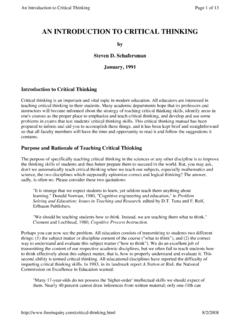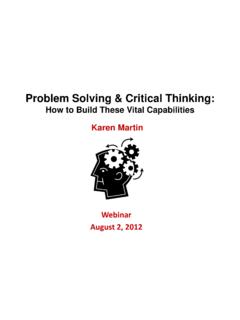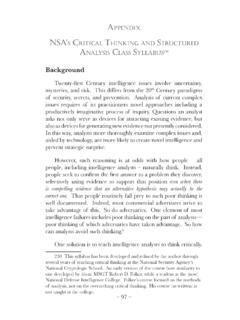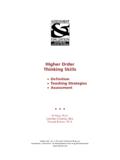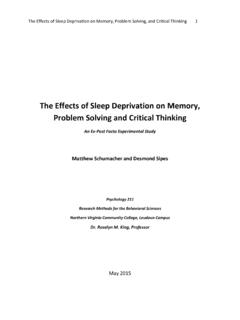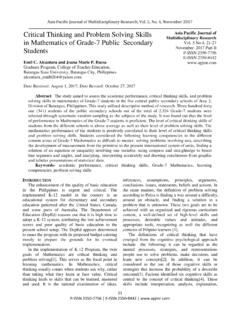Transcription of Higher Cognitive Learning: Critical Thinking & …
1 Higher Cognitive learning : Critical Thinking & problem SolvingDr Roisin DonnellyThe important thing is not to stop questioning-Albert EinsteinAll life is problem solving -PopperWhy is it important to encourage Higher - Cognitive learning ?Emphasis needs to be placed on incorporating the use of Higher -order thinkingand complex thinkingskills, as well as other 21st Century Skillssuch as collaborationand Skills Core Subjects and 21stCentury Themes Maths, Language Arts, Science, Social Studies Global Awareness and Civic Literacy Economic and Business Literacy Health Literacy learning and Innovation Skills Creativity Critical Thinking and problem solving Communication and Collaboration21stCentury 'Soft' skills play a central role in preparation for employmentin Ireland; The Irish Independent also singled out the National Competitiveness Council's call for skills such as Critical Thinking , problem solving , communication and self-directed learning in March this year (2010)The Millennial Generation Today s students are no longer the people our educational system was designed to teach Mark PrenskyCharacteristics of Digital Natives Active Multi-tasking Non-linear Thinking Ubiquity Technical Fluency Expectations of Feedback Individualization Risk-taking Information siftingTeaching Students to Think Theoretically & Empirically -do you agree?
2 learning to think theoreticallyand empiricallywithin a discipline is essential not only to learning its most important content but also to internalizing it as a dimension of lifelong Thinking and learning . Students should enter each course, therefore, prepared to internalize theoryas well as to analyzeand evaluateinformation. Unfortunately, we know all-too-well that students are not so prepared, but look to us to spoon-feed them "important" bits and pieces of stuff to memorize for the exam. Few students know how to isolate, or learn, important theories or important data. Critical Thinking as an Outcome for Higher Education Critical Thinking is a vital goal for Higher education( Browne & Freeman, 2000; Costa, 1991; Pithers& Soden, 2000) Critical Thinking is not a guaranteed outcome of college( , Halpern, 1996; Pascarella& Terenzini, 2005) Critical is Critical Thinking ? do you do when you think critically in your discipline?
3 Standards do you use to evaluate someone s Critical Thinking ? questions about teaching Critical Thinking do you hope to have answered today?Overview The session begins with a general introduction to Critical Thinking and problem solving and to their significance, not only to the academic but also to the vocational and personal success of students. It is followed by small group activities which are used to illustrate the application of various dimensions of problem solving and Critical Thinking strategies to ThinkingWe will explore it under 3 areas: UnderstandingCritical Thinking DevelopingCritical Thinking AssessingCritical ThinkingOverview Critical Thinking is an important element in all professional fields and academic disciplines. We often say to our students, "Think!" But what do we mean by Thinking and how do we encourage it? You will be introduced to the various types of Critical Thinking and demonstrate how to plan for ChallengeWrite a One Sentence Definition ofCRITICAL THINKINGC ritical Thinking Dearth of research that focuses on Critical Thinking as a distinct skilla willingness (a predisposition) and an ability to scrutinize and evaluate Thinking one s own, as well as others in order to determine truth, accuracy, or worth, and to construct logical arguments to justify claims or assertions -Beyer (1990) This boy shows great originality which must be curbed at all costs Sir Peter Ustinov Do you know ))Albert EinsteinAlbert Einsteinwas 4 years old before he could speak and 7 before he could read?
4 BeethovenBeethoven ssmusic teacher once told him, As a composer, you are hopeless? ))Winston ChurchillWinston Churchillfailed his first year in secondary school?))Isaac NewtonIsaac Newtondid poorly in primary school?))Thomas EdisonThomas Edison ssteacher told him that he was too stupid to learn anything?How? Barriers (students) Poor reading skills Poor listening skills Bias Binary reasoning Prejudice Fear of change Selective perception/attention Sociocentrism RelativismHow? Barriers (teachers) Unclear goals Misalignment Assessment criteria Time/Class size Content coverage Teaching without learning is just talking-Pat CrossHOW? A developmental approachSource: King, (2009). Developmental aspects of learning . Teagle-CRLT Science of learning Colloquium. Ann Arbor, Developing the use of sketchbooks as a tool to aid participation, ownership and Critical Thinking in art & design[the powerful potential of sketchbooks as tools to enable all ages to make life experiencesrelevant to learning ].
5 Sketchbooks, notebooks or journals as a creative learning tool are a hot topic at the moment and what's exciting is the potential fortheir use amongst many subject areas and in many contexts; sketchbooks belong to the user, not to the subject. Activity: Critical Thinking in the Disciplines In pairs, come up with some strategies for that you have used to foster Critical Thinking in your classroom. ActivityEmpowering students with Thinking skills such as: the ability to reason to make informed judgements to critically evaluate information to think creativelyCritical Thinking Theories The skills of Critical reasoning (such as the ability to assess reasons properly); A disposition, in the sense of: A Critical attitude (skepticism, the tendency to ask probing questions) and the commitment to give expression to this attitude, or A moral orientation which motivates Critical Thinking ; Substantial knowledge of particular content, whether of: Concepts in Critical Thinking (such as necessary and sufficient conditions), or of A particular discipline, in which one is then capable of Critical thought.
6 11 Mason, 2007, pp. Thinking Skills Ability to recognize and validate problems, Original, independent Thinking , Ability to develop theoretical concepts, Knowledge of recent advances within ones field, Understanding of relevant research methodologies and techniques, Ability to critically analyze and evaluate findings, Ability to summarize, document, report, and reflect on progress. 22 Andrews, 2007, p. 2. Cognitive Thinking Skills Interpretation Analysis Evaluation Inference Explanation Self-regulation 33 Facione, 2009, p. Thinking Strategies Decision Making Reasoning Investigation Experimental Inquiry Directed problem solving Creative problem solving Reflective Thinking EvaluationSkillsOutcomesWhy? Evaluating information Intellectual curiosity Tolerance for ambiguity Evaluating our habits of thought LIFE-LONG learning Analyzing Defining Inferring Synthesizing Listening Reasoning QUESTIONINGC ritical Thinking Dispositions Inquisitive Systematic Judicious Analytical Truthseeking Open-minded Confident in reasoning 44 Facione, 2009, p.
7 Critical Thinking Theories A four part model to unify and teach Critical Thinking skills and Critical Thinking dispositions: 5 Modeling Interactions Opportunities Feedback5 Yang and Chou, 2008, pp. Thinking Effective skills are intended to produce specific and generally pre-determined outcomes within a specific domain Significant debate still occurs in academia over what is Critical Thinking Critical Thinking has two components Cognitive Thinking skills Critical Thinking dispositionsTo help students learn how to think critically, teachers model expert Thinking talk about Thinking : cultivate students disposition to think critically align goals for student learning with assessment and teaching practices use tasks that make Critical Thinking and dialectical Thinking necessary and desirable create a classroom in which Critical Thinking is fostered and rewarded focus on the individual with specific formative feedback provide frequent opportunities for practice.
8 Give on-going opportunities for developing, practicing and refining the skillsof Thinking Use active methods to achieve learning goals Focus on the structure & content of problems to promote transferability Focus on the quality of participation Setting concrete expectations Engage students in challenging activities for a longer period oftime Vary communication tools according to the demands of the task Allow students to engage in metacognition How did you approach the problem ? How could you have approached it differently? What would the costs/benefits of an alternative course of action have been?Principles for fostering CTFostering Critical Thinking through teaching strategies Empower students with the language, tools and strategies to engage in a wide range of analytical, Critical and creative Thinking tasks Provide instruction and practice in ways of managing, organising and recording Thinking Engage students (particularly the more gifted learners)
9 In the high order Thinking skills Assist in the transfer of skills to everyday life and everyday situations as tools for lifelong Critical Thinking through teaching strategiesAchieving such outcomes will require more than the efforts of a few teachersoccasionally using one or twothinking strategies as part of their normal classroom essential element in developing a Thinking culture will be the explicit teaching of Thinking skills to all whole-school approach that provides a scope and sequence for the introduction of Thinking skills at specific year levels will have a much greater chance of the Appropriate Conditions for Critical Thinking :1. Motivation and Relevance Tasks should be problem -based(Dewey, 1993; Duffy, 2002) Tasks need to be personally relevant(Barab& Duffy, 1998) Tasks need to be authentic in their complexity(Brown et al, 1989; Innes, 2004; Resnik, 1987) Tasks need to encourage use of different contextual resources(Dewey, 1938; Dewey & Bentley, 1949) 2.
10 ScaffoldingMost learners need scaffolding(Quintana, Reiser, Davis, Krajcik, Fretz, Duncan, Kyza, Edelson, & Soloway,2004)Scaffolding = instructional techniques that would help learners attain goals and use skills that would otherwise be out of their reach (Davis & Miyake, 2004). Most learners need scaffolding for Critical Thinking Successful scaffolding = identification of processesthat promote Critical thinkingEXTERNALISATION Externalization = manifestation of changes in thought and attitude in the environment2. ScaffoldingARTICULATIONEVALUATIVE FEEDBACK3. Articulation Articulation = expression of thought in language either verballyor in written form. language is Critical to organize one s Thinking (Schunk,1999) the act of choosing words to represent our thoughts allows us to consider our ideas more deliberately (Vygotsky, 1987) Even in the absence of an audience articulation should promote Critical Thinking ( , journal, self-talk) implications for unreferenced messages and silence The presence of an audience, should further promote Critical Thinking The presence of an audience, should further promote Critical Thinking writing for an audience helps learners engage in Higher levels Thinking by pushing them to compact internal speech into a form that is understandable to others (Vygotsky, cited in Pugalee, 2004) writers do not simply express thought but transform it in certain complex but describable ways for the needs of a reader (Flower, 1997; )3.

